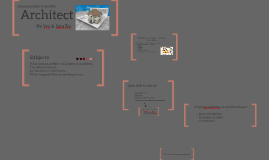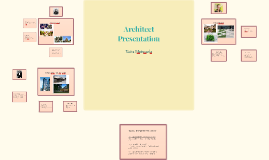Architect Presentation
Transcript: Claudia Petrielli Click to find out more about being an Architect and why I chose it as my future career! Architect GLC205b Ms. Di Paola DIFFERENT TYPES DIFFERENT TYPES OF ARCHITECTURE TECHNICAL TECHNICAL ARCHITECT The technical aspects of structural design are the focus of technical architects. They could, for instance, deal with a building's thermal efficacy. Before a facility is built, these architects oversee its details to make sure it abides with all the local safety regulations. PLANNING PLANNING ARCHITECT The planning of the design phase is often where these architects specialize. Planning architects give teams and businesses advice on how local restrictions and rules affect a structure's design. A planning architect will also request project permission from the local authority. DESIGN DESIGN ARCHITECT Design architects work on the layout of buildings. They will concentrate on developing a structure's original design, drawing out a model of the building in line with the client's requests, and choosing the project's materials. SITE SITE ARCHITECTS A site architect is the type of architect I am most intrested in right now. They are in charge of project design, implementation, and completion. Site architects typically work with building contractors to make sure a project has been built correctly and that safety standards are being followed. Site architects work both in an office and on the construction site desgining and making sure everything is going according to plan. EDUCATION NEEDED FOR AN ARCHITECT EDUCATION EDUCATION EDUCATION Obtaining the right education is the first step towards becoming an architect. There are several ways you can accomplish this: Doing 4 years of post-secondary education and earning a bachelor's degree. Doing 6 years of post-secondary education and earning a master's degree. INTERNSHIP INTERNSHIPS The Canadian Architectural Accreditation Board requires all future architects to complete internships before earning their liceneses. Students can look for internships on their own or through their university's internship coordinator. Most internships last three years or less and gives students the hands-on experience they need to become successful architects. PREPARING HOW I CAN PREPARE IN HIGH SCHOOL Some ways I can prepare to become an Architect in high school are: To take the Communications Technology course to become more familiar with editing and designing on computers. To take an Art course so I can furter develop my drawing skills. I can intern at an Architecture company during CO-OP in Grade 11. SKILLS SKILLS NEEDED TO BECOME AN ARCHITECT AND HOW COMFORTABLE I AM WITH THEM Math: Leadership: Communication: Project Managment: Creativity: Organization: WHY AM I INTRESTED IN BECOMING AN ARCHITECT? MY INTEREST Becoming an architect has intrested me for a while now. From what I have learned about myself, my work needs, and more about my personality, I feel being an architect is a good job for me. I enjoy online designing/editing, building things, I am organized and good at getting things done the right way. All these traits are used when being an architect. There are in-person and virtual pre-university summer school workshops at various universities in North America that are offered to high school students. I could take one of these courses on architecture to learn more about it. This will allow me to figure out if becoming an architect is the right career path for me. SALARY SALARY Average salaries of architects in provinces around Canada: Nunavut - $108,630 per year Northwest Territories - $101,385 per year Ontario - $100,613 per year Manitoba - $86,084 per year British Columbia - $82,274 per year Alberta - $81,672 per year Quebec - $70,260 per year Nova Scotia - $62,987 per year Prince Edward Island - 44,429 per year WORK CITED WORK CITED - Architecture admission requirements for Ontario high school students, University of Waterloo 1992-2021, uwaterloo.ca/future-students/admissions/admission-requirements/architecture/canada/ontario. Accessed 2 Oct. 2022. - How To Become an Architect, © 2022 Indeed, 21 June 2021, ca.indeed.com/career-advice/finding-a-job/how-to-become-an-architect. Accessed 2 Oct. 2022. - Architect salary in Ontario, © 2022 Indeed, 11 Sept. 2022, ca.indeed.com/career/architect/salaries/Ontario?cgtk=2245d424-f2fc-43d4-8c9e-f33cc26e1592&from=careeradvice-CA. Accessed 2 Oct. 2022. - Top 10 Highest Paying Architect Careers, ©2022 Brighton College, 24 Mar. 2022, brightoncollege.com/blog/top-10-highest-paying-architect-careers/#:~:text=However%20typically%20extreme%20architects%20make%20upwards%20of%20%24100%2C000%2B%20per%20year.. Accessed 2 Oct. 2022. - The Eight Types of Architects, Copyright Barker 2022, www.barker-associates.co.uk/service/architecture/different-types-of-architects/. Accessed 2 Oct. 2022.

















